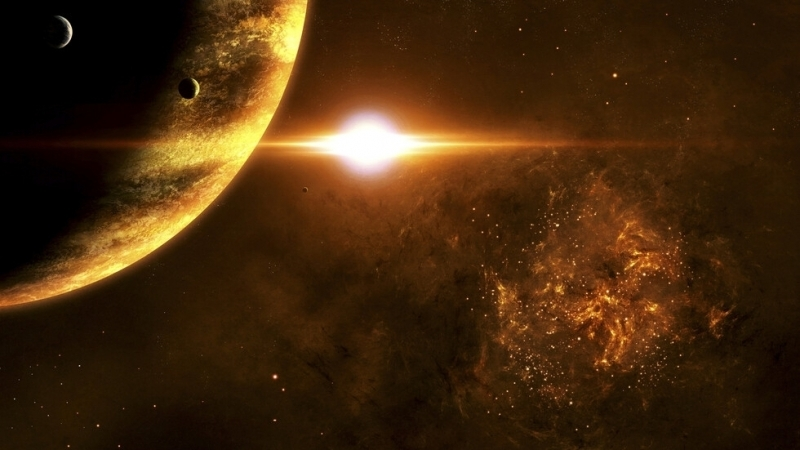"Zombie worlds" .. "scary" planets orbiting dead stars

Stars shine through a process of nuclear fusion in which lighter atoms such as hydrogen fuse together to form heavier atoms.
This process releases huge amounts of energy that counteract the constant inner pull of the star's gravity. Ultimately, the merger helps stars resist gravitational collapse.
This balance of forces is called "hydrostatic equilibrium". However, there will come a time when the fuel supply at the core of the star will start to run out and eventually die.
Stars with a mass more than eight times the mass of the Sun usually burn out with their fuel in less than 100 million years. Once the fusion stops, the star collapses - generating an instant, massive final explosion of nuclear fusion, which causes the star to explode in a supernova.
The supernova releases enough energy to outpace the galaxy in which it occurs. What remains after the collapse and death of stellar cores are called neutron stars or, if the dead star is massive enough, a black hole.
Any planets orbiting a star will be eliminated when it transforms into a supernova. But in mysterious circumstances, scientists have discovered a group of "zombie planets", which revolve around neutron stars, one of the strangest worlds in the universe.
Neutron stars are extremely dense, containing a mass equal to the mass of the Sun only a few miles away. Some neutron stars emit beams of radio waves into space - and planets have been found around these 'pulsating' stars.
As the pulsar rotates, radio beams sweep through space to generate regular radio flashes. The regularity of these radio pulses makes pulsars ideal for searching for nearby planets.
And if a pulsar had a planet, they would both orbit a common center of gravity. This means that the radio transmission will periodically expand and compress in a predictable manner - allowing us to discover the planet.
Phobetor , Poltergeist , and Draugr _
PSR B1257 + 12 is located about 2,300 light-years from Earth. It flashes 161 times per second and is nicknamed "Lich" after the "wizard of the dead" in Western folklore. It is orbited by three rocky terrestrial planets called Phobetor, Poltergeist, and Draugr.
These planets hold a special place in the history of astronomy, because they were the first outside our solar system (exoplanets), which were discovered in 1991. A few years ago, NASA revealed these “zombie worlds” saying: “Their discovery challenged ideas about planet formation, which usually occur in the form of a new star.In contrast, these planets must have formed after a supernova of the dying star. It is not yet known for certain how this happened. The material in a disk of debris orbiting the pulsar may have coalesced into planets after the supernova".
Draugr, named after a creature in Norse mythology, is the deepest of the three. Its mass is about twice the mass of the Moon, which is the least massive planet currently known, and it orbits "Leitch" every 25 days. Its larger cousins, Poltergeist and Phobetor, orbit every 67 and 98 days, respectively, and are each about four times the mass of Earth.
diamond world
Planet PSR J1719−1438b orbits a pulsar about 4,000 light-years away, and orbits its host in just over two hours. It is the densest planet ever discovered. While it is so dense, in fact, it is believed to be composed largely of diamonds.
This "diamond world" is the remaining core of a dead star called a white dwarf.
These dwarfs are known to contain a high proportion of carbon (and diamonds are made of carbon), but this particular white dwarf has lost 99.9% of its original mass, which was consumed by the strong gravity of the pulsar close to its host.
This diamond sphere is roughly half the size of Jupiter and orbits PSR J1719-1438 at a distance of 600,000 km (1.5 times farther from Earth).
t this distance from the host pulsar, this world would likely have an extremely hot surface.
Methuselah
Orbiting the Milky Way (and many galaxies) are globular star clusters, globular clusters of up to a million stars each. Which represent some of the oldest stars in the universe.
The globular star cluster Messier M4 is located about 5,600 light-years away and contains about 100,000 stars. Among them is a planet called Methuselah, after Ibn Idris in the Book of Genesis (the first books of the Torah/Pentateuch), who is supposed to have lived for 969 years.
At the center of the star cluster Messier 4 is a pulsar and a white dwarf that orbit their common center of gravity every 161 days.
Given the short-lived nature of high-mass stars, the pulsar may have formed shortly after Messier 4 itself.
Methuselah also orbits this center, but at a more comfortable pace, about once every 100 years or so, at a distance similar to that of Uranus orbiting our sun. It is a gas giant planet with a mass about 2.5 times that of Jupiter. It is believed that Methuselah formed as an ordinary planet around a sun-like star during the first billion years of the universe's formation. It was then captured in orbit around the host pulsar, which has been in its orbit ever since.
The high density of stars in globular clusters makes the chances of two stars meeting very close - as well as exchanging planets. Methuselah is the oldest known planet in the universe, having formed an estimated 12.7 billion years ago with all the stars in Messier 4.
Pulsars are extreme worlds, but they may not be the most exotic, as a few studies suggest the theory of planets orbiting black holes. So far, however, none have been found.
source:websites

